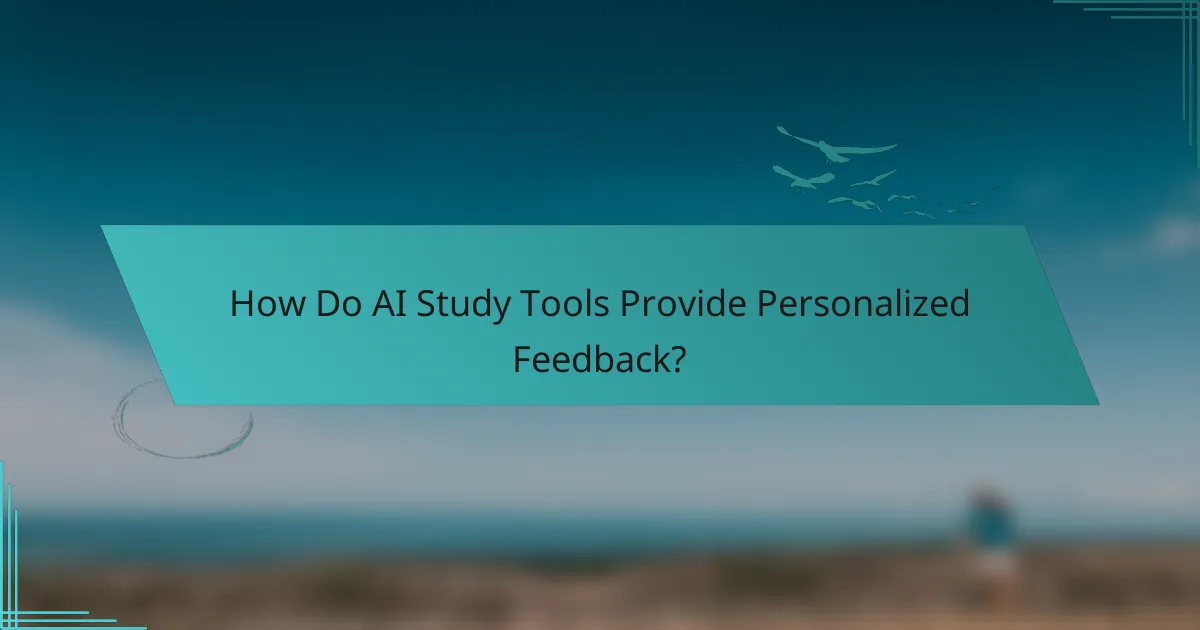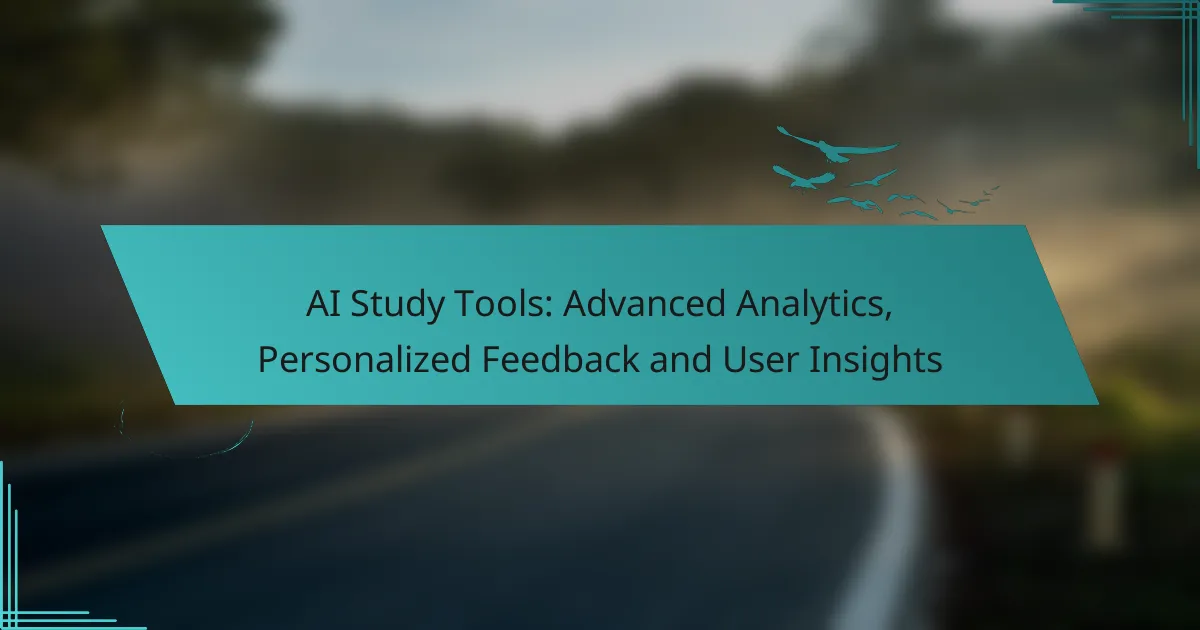AI study tools are revolutionizing education by utilizing advanced analytics to uncover learning patterns and performance metrics. By providing personalized feedback and tailored study plans, these tools empower users to identify their strengths and weaknesses, ultimately enhancing their educational experience. Additionally, the insights gained from user data allow both learners and educators to optimize their approaches for better outcomes.

What Are the Best AI Study Tools for Advanced Analytics?
The best AI study tools for advanced analytics leverage machine learning to provide insights into learning patterns and performance. These tools help users identify strengths and weaknesses, enabling personalized study plans that enhance educational outcomes.
Tool A: Features and Benefits
Tool A offers robust analytics capabilities that track user progress over time. It utilizes algorithms to analyze performance data, providing insights that help users focus on areas needing improvement.
Key benefits include personalized feedback based on individual learning styles and adaptive learning paths that adjust content difficulty according to user performance. This ensures that users are always challenged yet not overwhelmed.
Tool B: Features and Benefits
Tool B stands out with its real-time analytics dashboard, which visualizes user data in an easily digestible format. This feature allows learners to quickly assess their progress and make informed decisions about their study habits.
Additionally, Tool B integrates social learning features, enabling users to collaborate and share insights with peers. This communal aspect can enhance motivation and accountability, making study sessions more effective.
Tool C: Features and Benefits
Tool C focuses on predictive analytics, forecasting future performance based on current study habits. This can help users anticipate challenges and adjust their study strategies proactively.
Moreover, Tool C provides detailed reports that highlight trends in learning behavior, allowing for targeted interventions. Users can benefit from actionable recommendations tailored to their specific needs, enhancing overall learning efficiency.

How Do AI Study Tools Provide Personalized Feedback?
AI study tools deliver personalized feedback by analyzing user performance and adapting content to meet individual learning needs. These systems utilize advanced algorithms to assess strengths and weaknesses, offering tailored suggestions for improvement.
Feedback Mechanisms in Tool A
Tool A employs real-time analytics to track user interactions and performance metrics. By monitoring quiz results and study habits, it generates immediate feedback on areas needing attention, such as specific topics or question types.
For example, if a user struggles with math problems, Tool A will highlight these areas and suggest additional practice materials. This targeted approach helps learners focus their efforts effectively, maximizing study efficiency.
Feedback Mechanisms in Tool B
Tool B utilizes a combination of peer comparisons and adaptive learning paths to provide feedback. Users receive insights on how their performance stacks up against peers, which can motivate improvement and foster a competitive spirit.
Additionally, Tool B adjusts its content based on user engagement levels. If a learner consistently skips certain exercises, the tool may prompt them to revisit those topics, ensuring comprehensive understanding before moving forward.

What User Insights Can AI Study Tools Offer?
AI study tools can provide valuable user insights by analyzing learning patterns, preferences, and performance metrics. These insights help educators and learners tailor their approaches for improved outcomes.
Data Analytics in Tool A
Data analytics in Tool A involves collecting and interpreting various metrics related to user engagement and performance. This tool can track aspects such as time spent on tasks, accuracy rates, and completion times, allowing for a comprehensive view of a learner’s progress.
For example, if a student consistently takes longer to complete quizzes compared to peers, this may indicate areas where they struggle. Educators can then focus on these specific topics to provide additional support.
To maximize the benefits of data analytics, users should regularly review the generated reports and adjust their study strategies accordingly. Setting specific goals based on analytics can lead to more targeted learning efforts.
User Behavior Tracking in Tool B
User behavior tracking in Tool B focuses on monitoring how learners interact with the platform. This includes tracking clicks, navigation paths, and resource usage, which helps identify engagement levels and content effectiveness.
For instance, if analytics show that users frequently abandon a particular module, it may signal that the content is too challenging or not engaging enough. Adjustments can be made to enhance the learning experience based on these insights.
To effectively utilize user behavior tracking, consider implementing regular feedback loops where learners can express their experiences. This can complement the data collected and provide a fuller picture of user needs and preferences.

What Are the Key Criteria for Selecting AI Study Tools?
When selecting AI study tools, focus on integration capabilities, user experience design, and the ability to provide advanced analytics and personalized feedback. These criteria ensure that the tools enhance learning efficiency and adapt to individual needs.
Integration Capabilities
Integration capabilities refer to how well an AI study tool connects with existing educational platforms and resources. Tools that seamlessly integrate with Learning Management Systems (LMS) or other educational software can streamline workflows and enhance data sharing.
Look for tools that support popular platforms like Google Classroom or Microsoft Teams. This compatibility can save time and reduce the learning curve for both educators and students.
Consider the ease of setup and ongoing maintenance. Tools that require minimal configuration and offer robust support are typically more user-friendly and effective.
User Experience Design
User experience design is crucial for ensuring that learners can navigate AI study tools intuitively. A well-designed interface can significantly impact engagement and retention, making it easier for users to access features and understand analytics.
Evaluate the layout, accessibility, and responsiveness of the tool. Features like customizable dashboards and clear visualizations of progress can enhance the learning experience.
Prioritize tools that offer mobile-friendly designs, as many learners prefer studying on their smartphones or tablets. A responsive design can facilitate learning anytime and anywhere, increasing overall effectiveness.

How Do AI Study Tools Enhance Learning Outcomes?
AI study tools enhance learning outcomes by providing advanced analytics, personalized feedback, and user insights that cater to individual learning styles. These tools analyze performance data to identify strengths and weaknesses, enabling tailored study plans that improve retention and understanding.
Case Study: Tool A Impact
Tool A, an AI-driven platform, implemented personalized learning pathways based on student performance metrics. By analyzing quiz results and engagement levels, it adjusted content delivery to focus on areas where students struggled, resulting in a 30% increase in average test scores over a semester.
Additionally, Tool A provided real-time feedback, allowing students to correct mistakes immediately. This immediate reinforcement helped solidify concepts, leading to improved long-term retention of material.
Case Study: Tool B Impact
Tool B utilized advanced analytics to track user interactions and study habits. By identifying patterns in learning behaviors, it recommended specific resources and study techniques tailored to each user, which led to a noticeable improvement in user satisfaction and engagement rates.
In a pilot program, students using Tool B reported a 40% increase in confidence regarding their subject knowledge. The platform’s ability to adapt to individual learning preferences proved crucial in enhancing overall academic performance.

What Are the Emerging Trends in AI Study Tools?
Emerging trends in AI study tools focus on enhancing learning experiences through advanced analytics, personalized feedback, and user insights. These tools leverage artificial intelligence to adapt to individual learning styles, providing tailored content and support for better educational outcomes.
Adaptive Learning Technologies
Adaptive learning technologies use algorithms to assess a learner’s strengths and weaknesses, adjusting the educational material accordingly. This approach ensures that students receive content that matches their current knowledge level, promoting efficient learning paths.
For example, platforms like DreamBox or Smart Sparrow analyze user interactions and modify lessons in real-time. This can lead to improved retention rates and a more engaging learning experience, as students are not overwhelmed or bored by content that is too easy or too difficult.
When implementing adaptive learning, consider the integration of data analytics tools to track progress and identify areas needing improvement. Avoid over-reliance on technology; human oversight is crucial to ensure the learning experience remains effective and supportive.
AI-Driven Content Personalization
AI-driven content personalization tailors educational resources to individual preferences and learning styles, enhancing engagement and effectiveness. By analyzing user behavior and feedback, these systems can recommend specific materials, such as articles, videos, or quizzes, that resonate with each learner.
Tools like Coursera and Khan Academy utilize AI to suggest courses and resources based on a user’s previous interactions. This personalization can significantly improve motivation and learning outcomes, as students are more likely to engage with content that feels relevant to them.
To maximize the benefits of content personalization, regularly update the algorithms based on user feedback and performance metrics. Be cautious of creating echo chambers; ensure that learners are exposed to diverse perspectives and materials to foster a well-rounded understanding of subjects.
